Unilever's Competitive Advantage: Strategies in the UK Market
VerifiedAdded on 2023/06/15
|8
|2172
|458
Report
AI Summary
This report provides an analysis of how Unilever, a multinational retail organization operating in the United Kingdom, deals with market competition. It includes a PESTLE analysis, examining political, economic, social, technological, legal, and environmental factors impacting Unilever's business. The report discusses the competitive forces affecting Unilever, such as the bargaining power of suppliers and customers, and the threat of substitutes. Recommendations are provided for Unilever to enhance its competitive advantage, including technological innovation and focusing on customer needs. The analysis concludes that understanding the external business environment and developing effective competitive strategies are crucial for Unilever's success in the UK market.
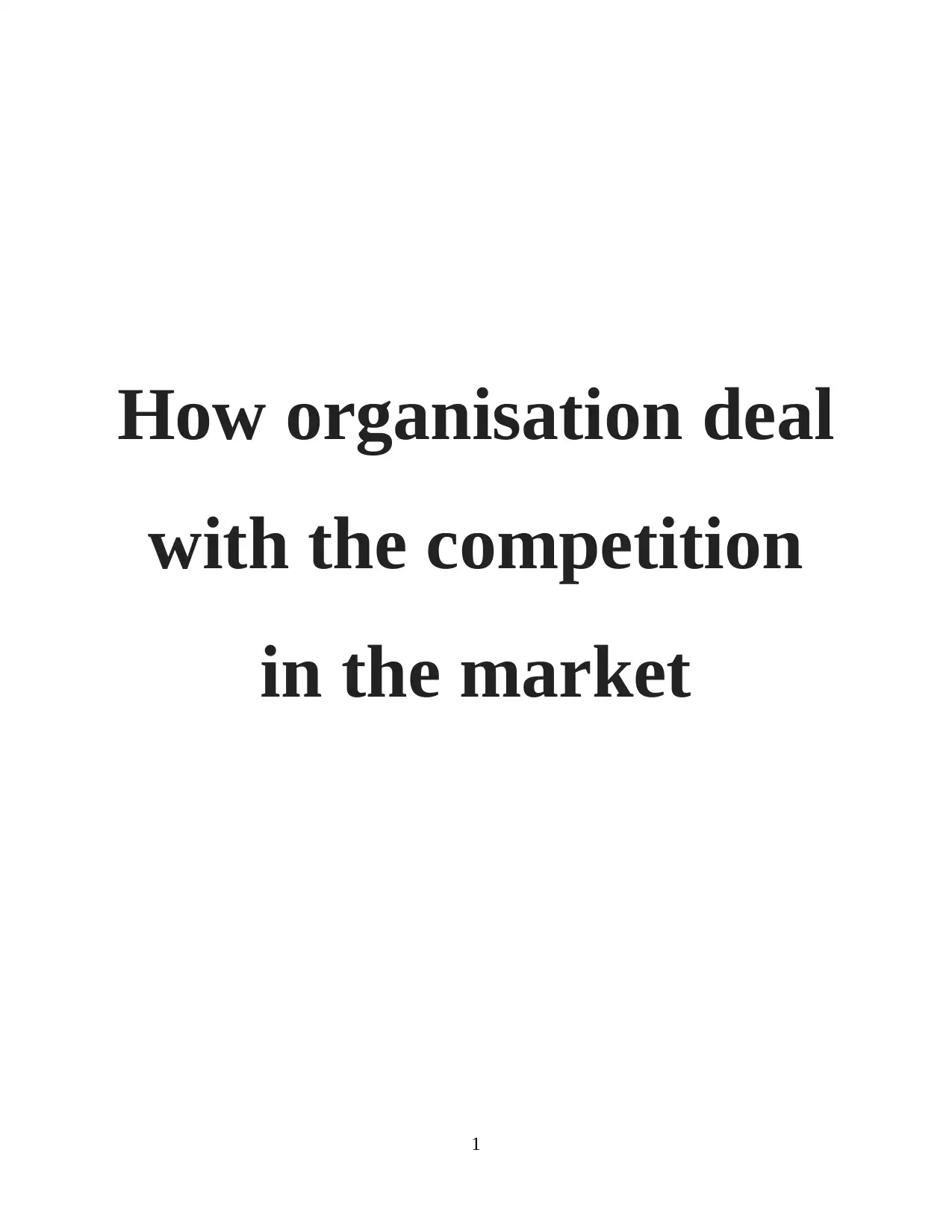
How organisation deal
with the competition
in the market
1
with the competition
in the market
1
Paraphrase This Document
Need a fresh take? Get an instant paraphrase of this document with our AI Paraphraser
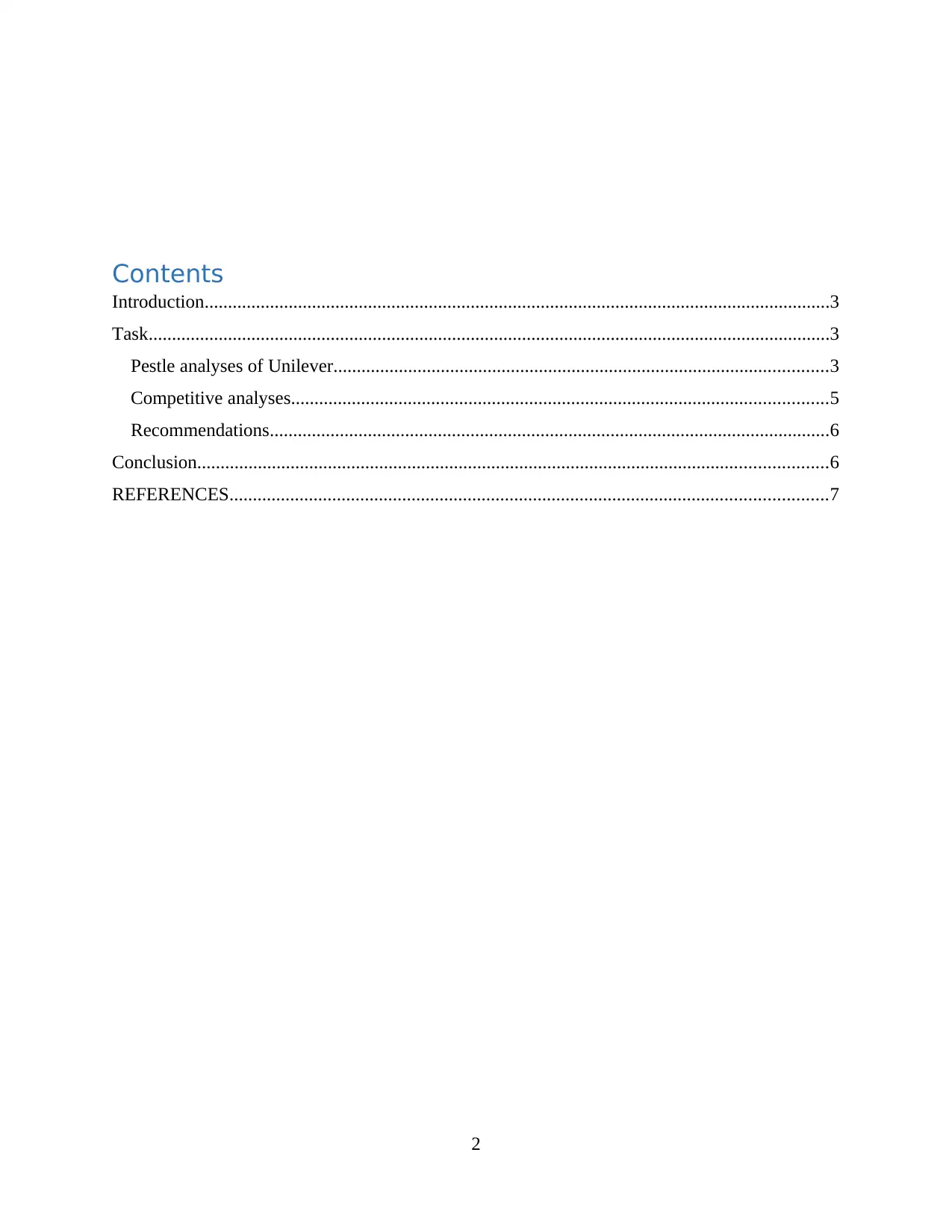
Contents
Introduction......................................................................................................................................3
Task..................................................................................................................................................3
Pestle analyses of Unilever..........................................................................................................3
Competitive analyses...................................................................................................................5
Recommendations........................................................................................................................6
Conclusion.......................................................................................................................................6
REFERENCES................................................................................................................................7
2
Introduction......................................................................................................................................3
Task..................................................................................................................................................3
Pestle analyses of Unilever..........................................................................................................3
Competitive analyses...................................................................................................................5
Recommendations........................................................................................................................6
Conclusion.......................................................................................................................................6
REFERENCES................................................................................................................................7
2
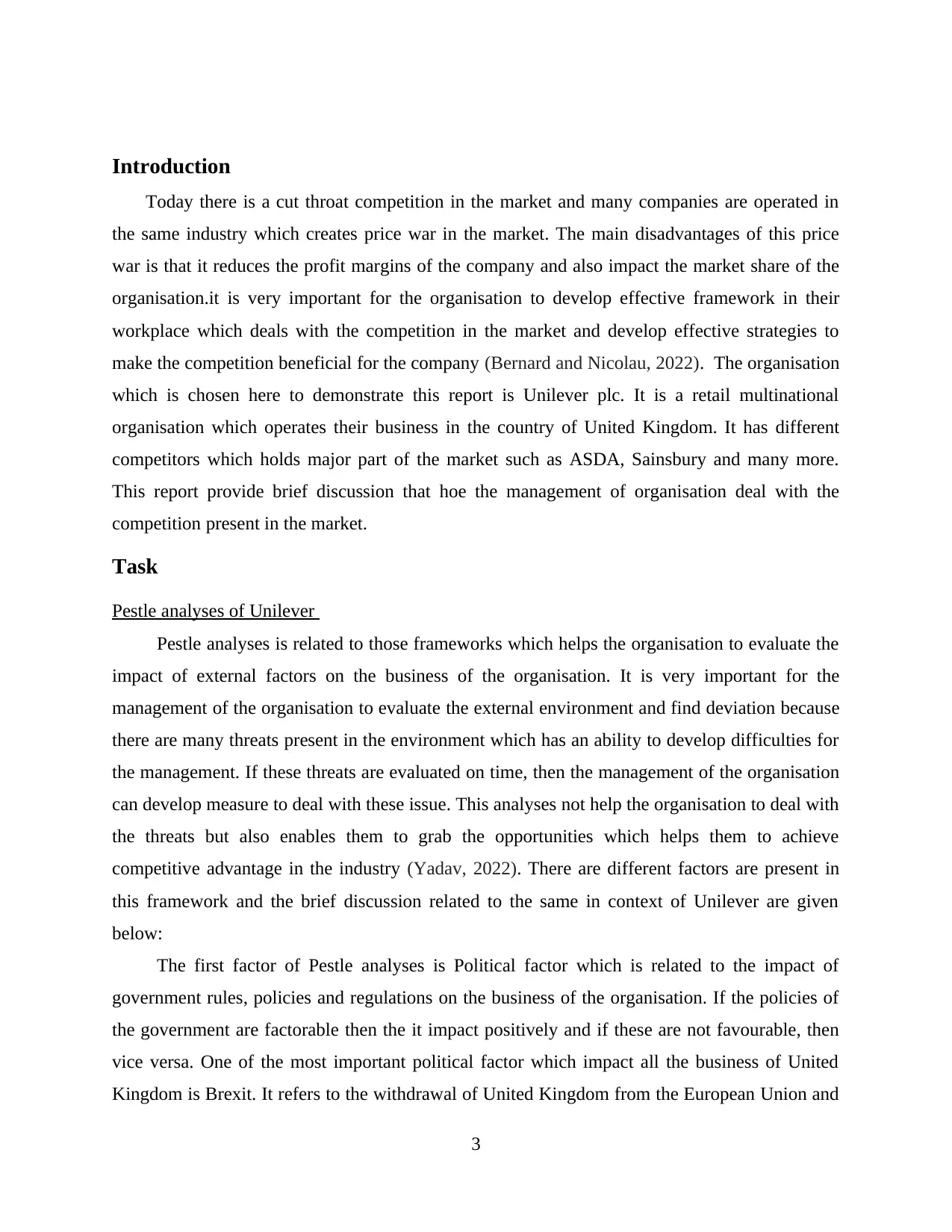
Introduction
Today there is a cut throat competition in the market and many companies are operated in
the same industry which creates price war in the market. The main disadvantages of this price
war is that it reduces the profit margins of the company and also impact the market share of the
organisation.it is very important for the organisation to develop effective framework in their
workplace which deals with the competition in the market and develop effective strategies to
make the competition beneficial for the company (Bernard and Nicolau, 2022). The organisation
which is chosen here to demonstrate this report is Unilever plc. It is a retail multinational
organisation which operates their business in the country of United Kingdom. It has different
competitors which holds major part of the market such as ASDA, Sainsbury and many more.
This report provide brief discussion that hoe the management of organisation deal with the
competition present in the market.
Task
Pestle analyses of Unilever
Pestle analyses is related to those frameworks which helps the organisation to evaluate the
impact of external factors on the business of the organisation. It is very important for the
management of the organisation to evaluate the external environment and find deviation because
there are many threats present in the environment which has an ability to develop difficulties for
the management. If these threats are evaluated on time, then the management of the organisation
can develop measure to deal with these issue. This analyses not help the organisation to deal with
the threats but also enables them to grab the opportunities which helps them to achieve
competitive advantage in the industry (Yadav, 2022). There are different factors are present in
this framework and the brief discussion related to the same in context of Unilever are given
below:
The first factor of Pestle analyses is Political factor which is related to the impact of
government rules, policies and regulations on the business of the organisation. If the policies of
the government are factorable then the it impact positively and if these are not favourable, then
vice versa. One of the most important political factor which impact all the business of United
Kingdom is Brexit. It refers to the withdrawal of United Kingdom from the European Union and
3
Today there is a cut throat competition in the market and many companies are operated in
the same industry which creates price war in the market. The main disadvantages of this price
war is that it reduces the profit margins of the company and also impact the market share of the
organisation.it is very important for the organisation to develop effective framework in their
workplace which deals with the competition in the market and develop effective strategies to
make the competition beneficial for the company (Bernard and Nicolau, 2022). The organisation
which is chosen here to demonstrate this report is Unilever plc. It is a retail multinational
organisation which operates their business in the country of United Kingdom. It has different
competitors which holds major part of the market such as ASDA, Sainsbury and many more.
This report provide brief discussion that hoe the management of organisation deal with the
competition present in the market.
Task
Pestle analyses of Unilever
Pestle analyses is related to those frameworks which helps the organisation to evaluate the
impact of external factors on the business of the organisation. It is very important for the
management of the organisation to evaluate the external environment and find deviation because
there are many threats present in the environment which has an ability to develop difficulties for
the management. If these threats are evaluated on time, then the management of the organisation
can develop measure to deal with these issue. This analyses not help the organisation to deal with
the threats but also enables them to grab the opportunities which helps them to achieve
competitive advantage in the industry (Yadav, 2022). There are different factors are present in
this framework and the brief discussion related to the same in context of Unilever are given
below:
The first factor of Pestle analyses is Political factor which is related to the impact of
government rules, policies and regulations on the business of the organisation. If the policies of
the government are factorable then the it impact positively and if these are not favourable, then
vice versa. One of the most important political factor which impact all the business of United
Kingdom is Brexit. It refers to the withdrawal of United Kingdom from the European Union and
3
⊘ This is a preview!⊘
Do you want full access?
Subscribe today to unlock all pages.

Trusted by 1+ million students worldwide
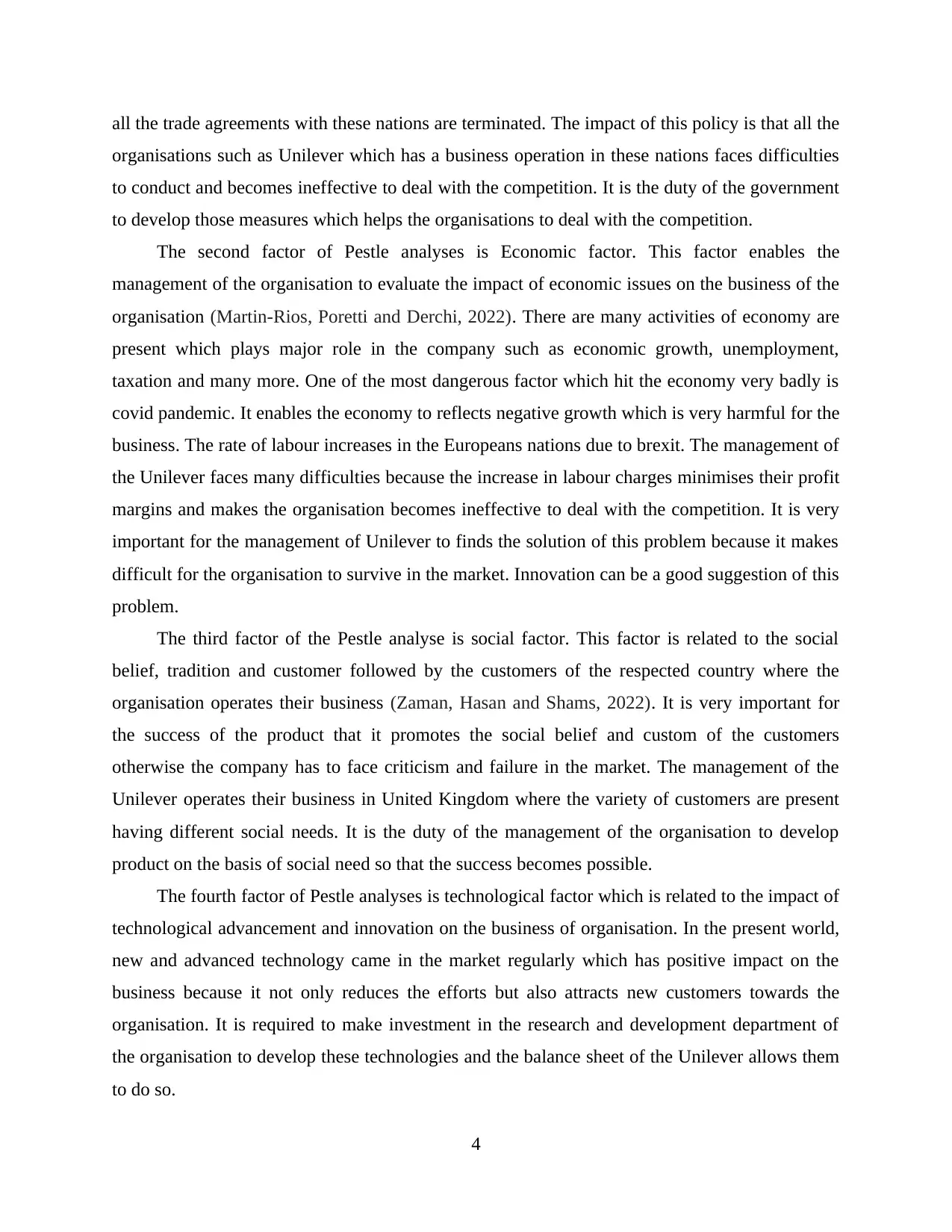
all the trade agreements with these nations are terminated. The impact of this policy is that all the
organisations such as Unilever which has a business operation in these nations faces difficulties
to conduct and becomes ineffective to deal with the competition. It is the duty of the government
to develop those measures which helps the organisations to deal with the competition.
The second factor of Pestle analyses is Economic factor. This factor enables the
management of the organisation to evaluate the impact of economic issues on the business of the
organisation (Martin-Rios, Poretti and Derchi, 2022). There are many activities of economy are
present which plays major role in the company such as economic growth, unemployment,
taxation and many more. One of the most dangerous factor which hit the economy very badly is
covid pandemic. It enables the economy to reflects negative growth which is very harmful for the
business. The rate of labour increases in the Europeans nations due to brexit. The management of
the Unilever faces many difficulties because the increase in labour charges minimises their profit
margins and makes the organisation becomes ineffective to deal with the competition. It is very
important for the management of Unilever to finds the solution of this problem because it makes
difficult for the organisation to survive in the market. Innovation can be a good suggestion of this
problem.
The third factor of the Pestle analyse is social factor. This factor is related to the social
belief, tradition and customer followed by the customers of the respected country where the
organisation operates their business (Zaman, Hasan and Shams, 2022). It is very important for
the success of the product that it promotes the social belief and custom of the customers
otherwise the company has to face criticism and failure in the market. The management of the
Unilever operates their business in United Kingdom where the variety of customers are present
having different social needs. It is the duty of the management of the organisation to develop
product on the basis of social need so that the success becomes possible.
The fourth factor of Pestle analyses is technological factor which is related to the impact of
technological advancement and innovation on the business of organisation. In the present world,
new and advanced technology came in the market regularly which has positive impact on the
business because it not only reduces the efforts but also attracts new customers towards the
organisation. It is required to make investment in the research and development department of
the organisation to develop these technologies and the balance sheet of the Unilever allows them
to do so.
4
organisations such as Unilever which has a business operation in these nations faces difficulties
to conduct and becomes ineffective to deal with the competition. It is the duty of the government
to develop those measures which helps the organisations to deal with the competition.
The second factor of Pestle analyses is Economic factor. This factor enables the
management of the organisation to evaluate the impact of economic issues on the business of the
organisation (Martin-Rios, Poretti and Derchi, 2022). There are many activities of economy are
present which plays major role in the company such as economic growth, unemployment,
taxation and many more. One of the most dangerous factor which hit the economy very badly is
covid pandemic. It enables the economy to reflects negative growth which is very harmful for the
business. The rate of labour increases in the Europeans nations due to brexit. The management of
the Unilever faces many difficulties because the increase in labour charges minimises their profit
margins and makes the organisation becomes ineffective to deal with the competition. It is very
important for the management of Unilever to finds the solution of this problem because it makes
difficult for the organisation to survive in the market. Innovation can be a good suggestion of this
problem.
The third factor of the Pestle analyse is social factor. This factor is related to the social
belief, tradition and customer followed by the customers of the respected country where the
organisation operates their business (Zaman, Hasan and Shams, 2022). It is very important for
the success of the product that it promotes the social belief and custom of the customers
otherwise the company has to face criticism and failure in the market. The management of the
Unilever operates their business in United Kingdom where the variety of customers are present
having different social needs. It is the duty of the management of the organisation to develop
product on the basis of social need so that the success becomes possible.
The fourth factor of Pestle analyses is technological factor which is related to the impact of
technological advancement and innovation on the business of organisation. In the present world,
new and advanced technology came in the market regularly which has positive impact on the
business because it not only reduces the efforts but also attracts new customers towards the
organisation. It is required to make investment in the research and development department of
the organisation to develop these technologies and the balance sheet of the Unilever allows them
to do so.
4
Paraphrase This Document
Need a fresh take? Get an instant paraphrase of this document with our AI Paraphraser
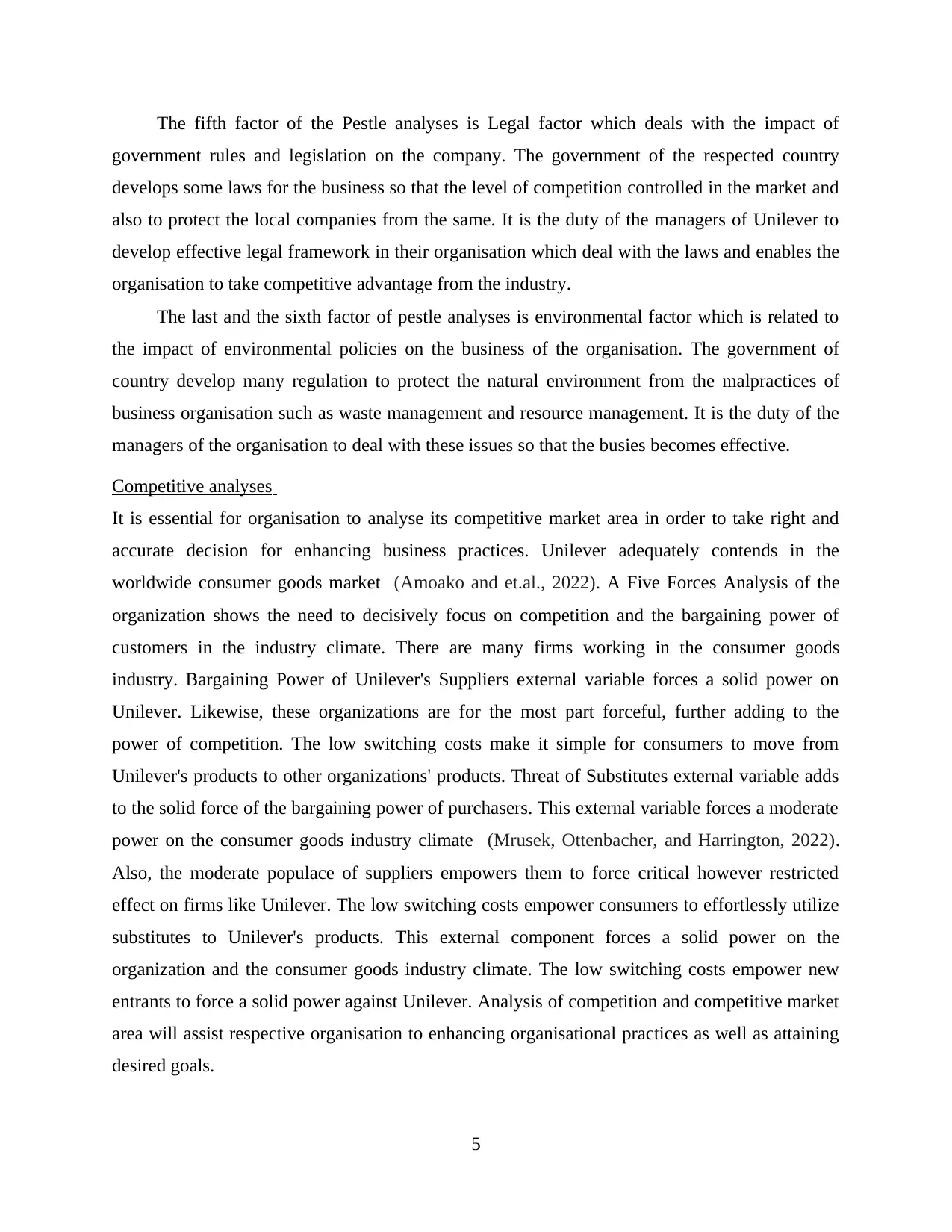
The fifth factor of the Pestle analyses is Legal factor which deals with the impact of
government rules and legislation on the company. The government of the respected country
develops some laws for the business so that the level of competition controlled in the market and
also to protect the local companies from the same. It is the duty of the managers of Unilever to
develop effective legal framework in their organisation which deal with the laws and enables the
organisation to take competitive advantage from the industry.
The last and the sixth factor of pestle analyses is environmental factor which is related to
the impact of environmental policies on the business of the organisation. The government of
country develop many regulation to protect the natural environment from the malpractices of
business organisation such as waste management and resource management. It is the duty of the
managers of the organisation to deal with these issues so that the busies becomes effective.
Competitive analyses
It is essential for organisation to analyse its competitive market area in order to take right and
accurate decision for enhancing business practices. Unilever adequately contends in the
worldwide consumer goods market (Amoako and et.al., 2022). A Five Forces Analysis of the
organization shows the need to decisively focus on competition and the bargaining power of
customers in the industry climate. There are many firms working in the consumer goods
industry. Bargaining Power of Unilever's Suppliers external variable forces a solid power on
Unilever. Likewise, these organizations are for the most part forceful, further adding to the
power of competition. The low switching costs make it simple for consumers to move from
Unilever's products to other organizations' products. Threat of Substitutes external variable adds
to the solid force of the bargaining power of purchasers. This external variable forces a moderate
power on the consumer goods industry climate (Mrusek, Ottenbacher, and Harrington, 2022).
Also, the moderate populace of suppliers empowers them to force critical however restricted
effect on firms like Unilever. The low switching costs empower consumers to effortlessly utilize
substitutes to Unilever's products. This external component forces a solid power on the
organization and the consumer goods industry climate. The low switching costs empower new
entrants to force a solid power against Unilever. Analysis of competition and competitive market
area will assist respective organisation to enhancing organisational practices as well as attaining
desired goals.
5
government rules and legislation on the company. The government of the respected country
develops some laws for the business so that the level of competition controlled in the market and
also to protect the local companies from the same. It is the duty of the managers of Unilever to
develop effective legal framework in their organisation which deal with the laws and enables the
organisation to take competitive advantage from the industry.
The last and the sixth factor of pestle analyses is environmental factor which is related to
the impact of environmental policies on the business of the organisation. The government of
country develop many regulation to protect the natural environment from the malpractices of
business organisation such as waste management and resource management. It is the duty of the
managers of the organisation to deal with these issues so that the busies becomes effective.
Competitive analyses
It is essential for organisation to analyse its competitive market area in order to take right and
accurate decision for enhancing business practices. Unilever adequately contends in the
worldwide consumer goods market (Amoako and et.al., 2022). A Five Forces Analysis of the
organization shows the need to decisively focus on competition and the bargaining power of
customers in the industry climate. There are many firms working in the consumer goods
industry. Bargaining Power of Unilever's Suppliers external variable forces a solid power on
Unilever. Likewise, these organizations are for the most part forceful, further adding to the
power of competition. The low switching costs make it simple for consumers to move from
Unilever's products to other organizations' products. Threat of Substitutes external variable adds
to the solid force of the bargaining power of purchasers. This external variable forces a moderate
power on the consumer goods industry climate (Mrusek, Ottenbacher, and Harrington, 2022).
Also, the moderate populace of suppliers empowers them to force critical however restricted
effect on firms like Unilever. The low switching costs empower consumers to effortlessly utilize
substitutes to Unilever's products. This external component forces a solid power on the
organization and the consumer goods industry climate. The low switching costs empower new
entrants to force a solid power against Unilever. Analysis of competition and competitive market
area will assist respective organisation to enhancing organisational practices as well as attaining
desired goals.
5
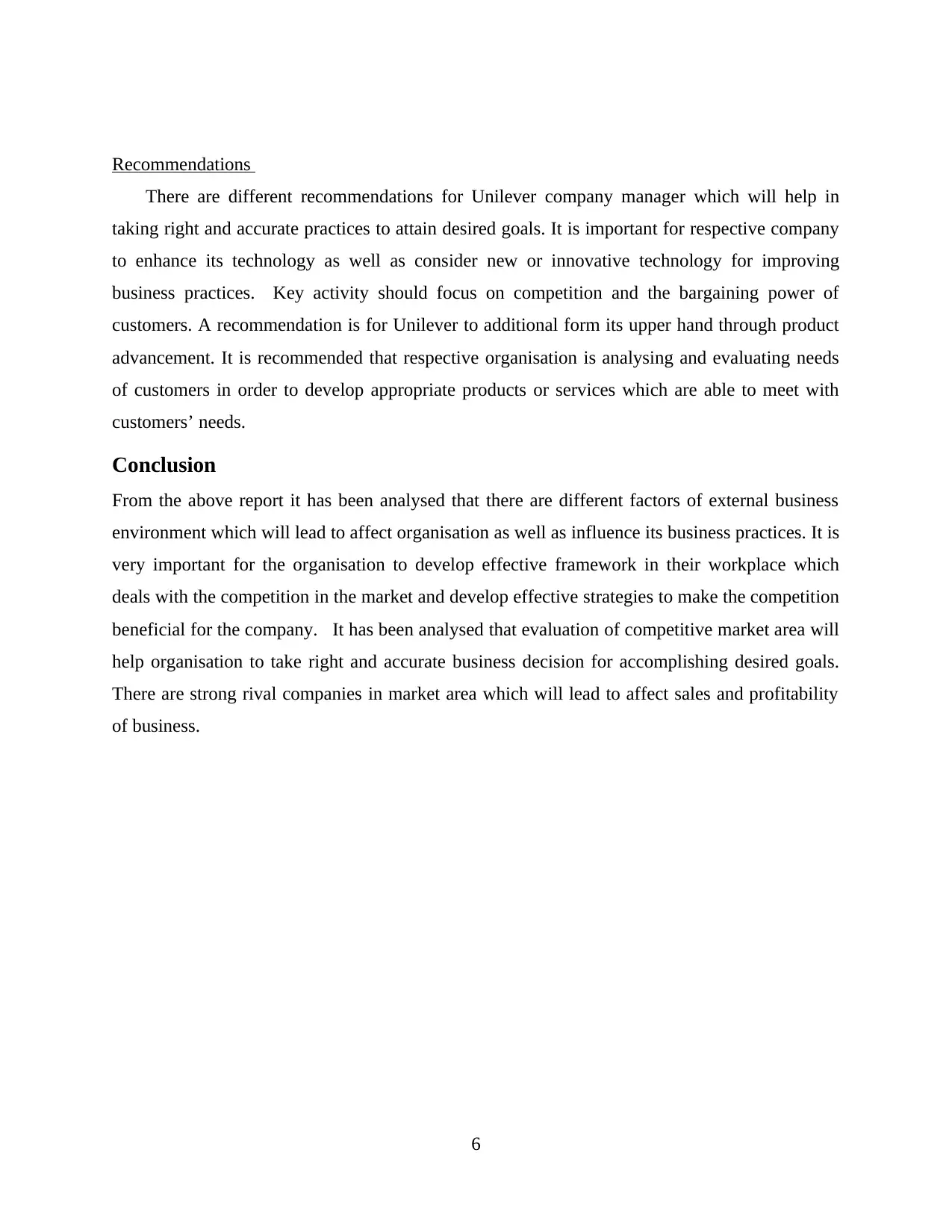
Recommendations
There are different recommendations for Unilever company manager which will help in
taking right and accurate practices to attain desired goals. It is important for respective company
to enhance its technology as well as consider new or innovative technology for improving
business practices. Key activity should focus on competition and the bargaining power of
customers. A recommendation is for Unilever to additional form its upper hand through product
advancement. It is recommended that respective organisation is analysing and evaluating needs
of customers in order to develop appropriate products or services which are able to meet with
customers’ needs.
Conclusion
From the above report it has been analysed that there are different factors of external business
environment which will lead to affect organisation as well as influence its business practices. It is
very important for the organisation to develop effective framework in their workplace which
deals with the competition in the market and develop effective strategies to make the competition
beneficial for the company. It has been analysed that evaluation of competitive market area will
help organisation to take right and accurate business decision for accomplishing desired goals.
There are strong rival companies in market area which will lead to affect sales and profitability
of business.
6
There are different recommendations for Unilever company manager which will help in
taking right and accurate practices to attain desired goals. It is important for respective company
to enhance its technology as well as consider new or innovative technology for improving
business practices. Key activity should focus on competition and the bargaining power of
customers. A recommendation is for Unilever to additional form its upper hand through product
advancement. It is recommended that respective organisation is analysing and evaluating needs
of customers in order to develop appropriate products or services which are able to meet with
customers’ needs.
Conclusion
From the above report it has been analysed that there are different factors of external business
environment which will lead to affect organisation as well as influence its business practices. It is
very important for the organisation to develop effective framework in their workplace which
deals with the competition in the market and develop effective strategies to make the competition
beneficial for the company. It has been analysed that evaluation of competitive market area will
help organisation to take right and accurate business decision for accomplishing desired goals.
There are strong rival companies in market area which will lead to affect sales and profitability
of business.
6
⊘ This is a preview!⊘
Do you want full access?
Subscribe today to unlock all pages.

Trusted by 1+ million students worldwide
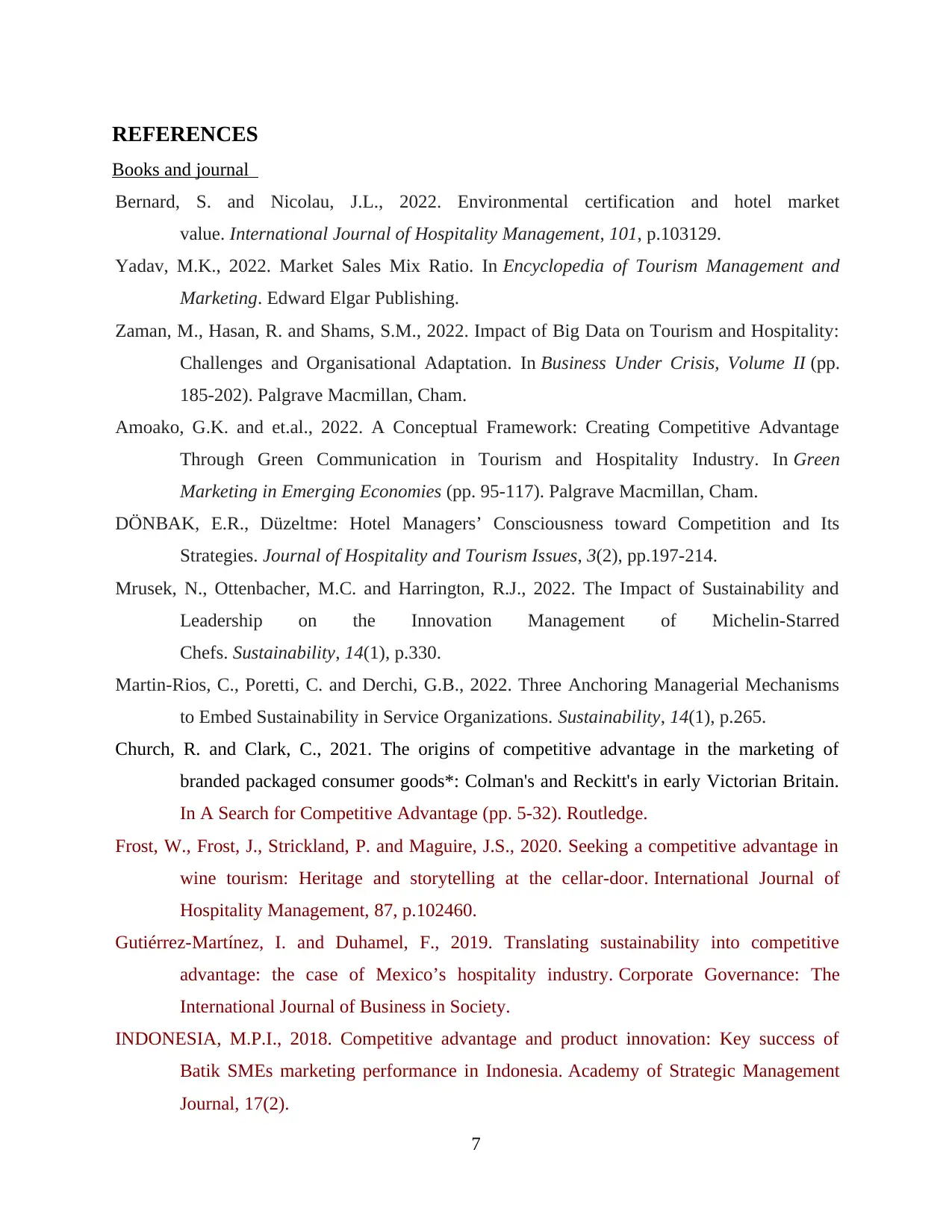
REFERENCES
Books and journal
Bernard, S. and Nicolau, J.L., 2022. Environmental certification and hotel market
value. International Journal of Hospitality Management, 101, p.103129.
Yadav, M.K., 2022. Market Sales Mix Ratio. In Encyclopedia of Tourism Management and
Marketing. Edward Elgar Publishing.
Zaman, M., Hasan, R. and Shams, S.M., 2022. Impact of Big Data on Tourism and Hospitality:
Challenges and Organisational Adaptation. In Business Under Crisis, Volume II (pp.
185-202). Palgrave Macmillan, Cham.
Amoako, G.K. and et.al., 2022. A Conceptual Framework: Creating Competitive Advantage
Through Green Communication in Tourism and Hospitality Industry. In Green
Marketing in Emerging Economies (pp. 95-117). Palgrave Macmillan, Cham.
DÖNBAK, E.R., Düzeltme: Hotel Managers’ Consciousness toward Competition and Its
Strategies. Journal of Hospitality and Tourism Issues, 3(2), pp.197-214.
Mrusek, N., Ottenbacher, M.C. and Harrington, R.J., 2022. The Impact of Sustainability and
Leadership on the Innovation Management of Michelin-Starred
Chefs. Sustainability, 14(1), p.330.
Martin-Rios, C., Poretti, C. and Derchi, G.B., 2022. Three Anchoring Managerial Mechanisms
to Embed Sustainability in Service Organizations. Sustainability, 14(1), p.265.
Church, R. and Clark, C., 2021. The origins of competitive advantage in the marketing of
branded packaged consumer goods*: Colman's and Reckitt's in early Victorian Britain.
In A Search for Competitive Advantage (pp. 5-32). Routledge.
Frost, W., Frost, J., Strickland, P. and Maguire, J.S., 2020. Seeking a competitive advantage in
wine tourism: Heritage and storytelling at the cellar-door. International Journal of
Hospitality Management, 87, p.102460.
Gutiérrez-Martínez, I. and Duhamel, F., 2019. Translating sustainability into competitive
advantage: the case of Mexico’s hospitality industry. Corporate Governance: The
International Journal of Business in Society.
INDONESIA, M.P.I., 2018. Competitive advantage and product innovation: Key success of
Batik SMEs marketing performance in Indonesia. Academy of Strategic Management
Journal, 17(2).
7
Books and journal
Bernard, S. and Nicolau, J.L., 2022. Environmental certification and hotel market
value. International Journal of Hospitality Management, 101, p.103129.
Yadav, M.K., 2022. Market Sales Mix Ratio. In Encyclopedia of Tourism Management and
Marketing. Edward Elgar Publishing.
Zaman, M., Hasan, R. and Shams, S.M., 2022. Impact of Big Data on Tourism and Hospitality:
Challenges and Organisational Adaptation. In Business Under Crisis, Volume II (pp.
185-202). Palgrave Macmillan, Cham.
Amoako, G.K. and et.al., 2022. A Conceptual Framework: Creating Competitive Advantage
Through Green Communication in Tourism and Hospitality Industry. In Green
Marketing in Emerging Economies (pp. 95-117). Palgrave Macmillan, Cham.
DÖNBAK, E.R., Düzeltme: Hotel Managers’ Consciousness toward Competition and Its
Strategies. Journal of Hospitality and Tourism Issues, 3(2), pp.197-214.
Mrusek, N., Ottenbacher, M.C. and Harrington, R.J., 2022. The Impact of Sustainability and
Leadership on the Innovation Management of Michelin-Starred
Chefs. Sustainability, 14(1), p.330.
Martin-Rios, C., Poretti, C. and Derchi, G.B., 2022. Three Anchoring Managerial Mechanisms
to Embed Sustainability in Service Organizations. Sustainability, 14(1), p.265.
Church, R. and Clark, C., 2021. The origins of competitive advantage in the marketing of
branded packaged consumer goods*: Colman's and Reckitt's in early Victorian Britain.
In A Search for Competitive Advantage (pp. 5-32). Routledge.
Frost, W., Frost, J., Strickland, P. and Maguire, J.S., 2020. Seeking a competitive advantage in
wine tourism: Heritage and storytelling at the cellar-door. International Journal of
Hospitality Management, 87, p.102460.
Gutiérrez-Martínez, I. and Duhamel, F., 2019. Translating sustainability into competitive
advantage: the case of Mexico’s hospitality industry. Corporate Governance: The
International Journal of Business in Society.
INDONESIA, M.P.I., 2018. Competitive advantage and product innovation: Key success of
Batik SMEs marketing performance in Indonesia. Academy of Strategic Management
Journal, 17(2).
7
Paraphrase This Document
Need a fresh take? Get an instant paraphrase of this document with our AI Paraphraser
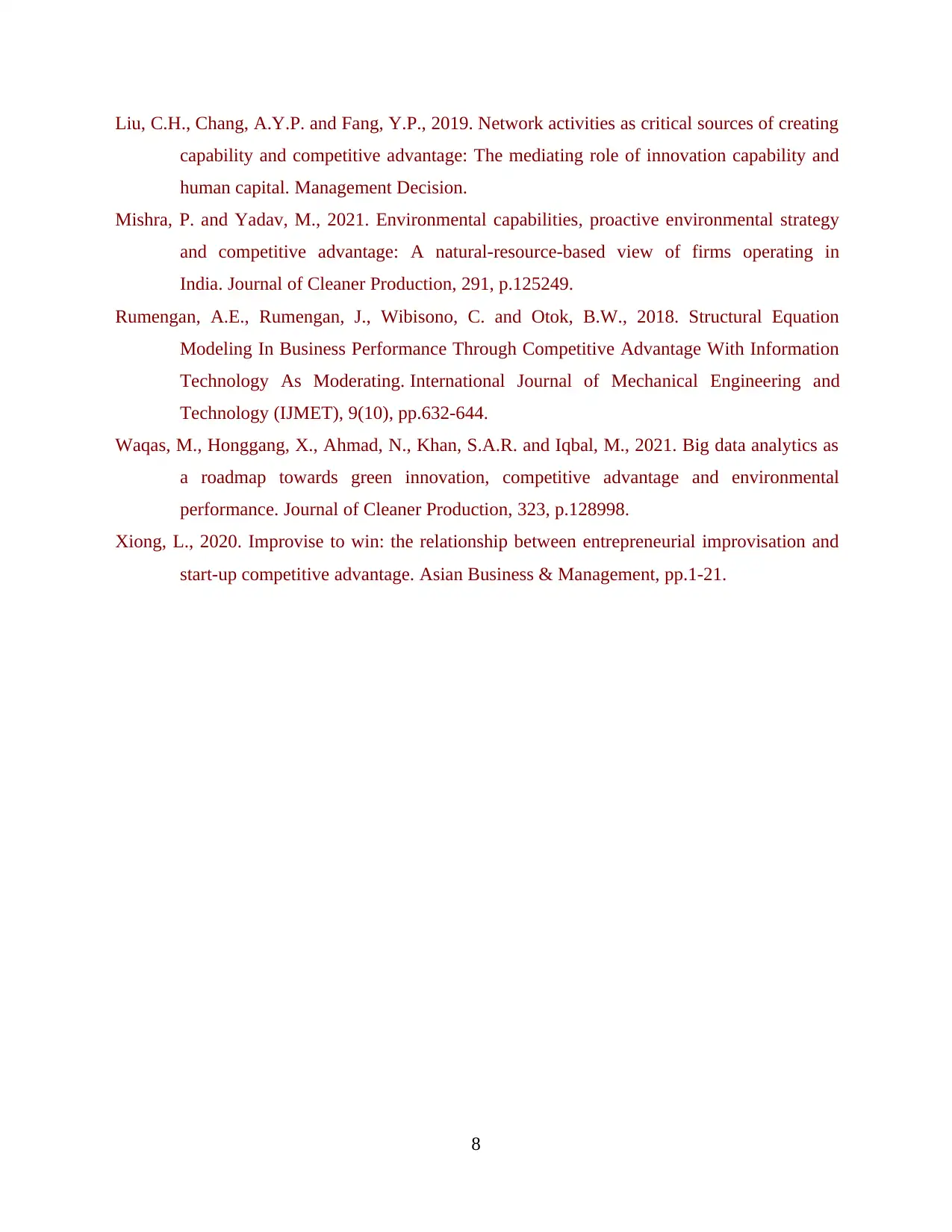
Liu, C.H., Chang, A.Y.P. and Fang, Y.P., 2019. Network activities as critical sources of creating
capability and competitive advantage: The mediating role of innovation capability and
human capital. Management Decision.
Mishra, P. and Yadav, M., 2021. Environmental capabilities, proactive environmental strategy
and competitive advantage: A natural-resource-based view of firms operating in
India. Journal of Cleaner Production, 291, p.125249.
Rumengan, A.E., Rumengan, J., Wibisono, C. and Otok, B.W., 2018. Structural Equation
Modeling In Business Performance Through Competitive Advantage With Information
Technology As Moderating. International Journal of Mechanical Engineering and
Technology (IJMET), 9(10), pp.632-644.
Waqas, M., Honggang, X., Ahmad, N., Khan, S.A.R. and Iqbal, M., 2021. Big data analytics as
a roadmap towards green innovation, competitive advantage and environmental
performance. Journal of Cleaner Production, 323, p.128998.
Xiong, L., 2020. Improvise to win: the relationship between entrepreneurial improvisation and
start-up competitive advantage. Asian Business & Management, pp.1-21.
8
capability and competitive advantage: The mediating role of innovation capability and
human capital. Management Decision.
Mishra, P. and Yadav, M., 2021. Environmental capabilities, proactive environmental strategy
and competitive advantage: A natural-resource-based view of firms operating in
India. Journal of Cleaner Production, 291, p.125249.
Rumengan, A.E., Rumengan, J., Wibisono, C. and Otok, B.W., 2018. Structural Equation
Modeling In Business Performance Through Competitive Advantage With Information
Technology As Moderating. International Journal of Mechanical Engineering and
Technology (IJMET), 9(10), pp.632-644.
Waqas, M., Honggang, X., Ahmad, N., Khan, S.A.R. and Iqbal, M., 2021. Big data analytics as
a roadmap towards green innovation, competitive advantage and environmental
performance. Journal of Cleaner Production, 323, p.128998.
Xiong, L., 2020. Improvise to win: the relationship between entrepreneurial improvisation and
start-up competitive advantage. Asian Business & Management, pp.1-21.
8
1 out of 8
Related Documents
Your All-in-One AI-Powered Toolkit for Academic Success.
+13062052269
info@desklib.com
Available 24*7 on WhatsApp / Email
![[object Object]](/_next/static/media/star-bottom.7253800d.svg)
Unlock your academic potential
Copyright © 2020–2025 A2Z Services. All Rights Reserved. Developed and managed by ZUCOL.



